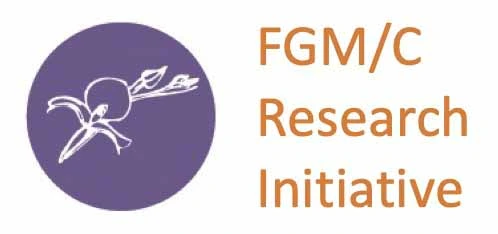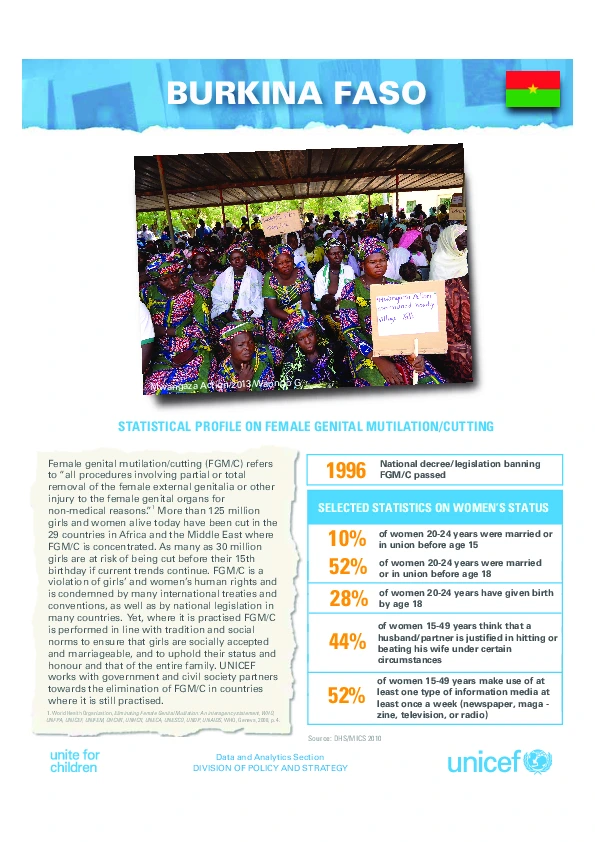Home | Research & Resources | Burkina Faso
Key Findings
The prevalence of FGM/C among women aged 15–49 in Burkina Faso is 56.1%.
More than 85% of Burkinabé women are against its continuation.
Geography
The regions with the highest prevalence lie in the south-west and in a band across the country from the centre-east towards the north
Age
87.5% of women aged 15–19 who have undergone FGM/C were cut before the age of ten
Type
‘Cut, flesh removed’ is the most common type of FGM/C practised
Agent
Almost all FGM/C is carried out by ‘traditional agents’ (including traditional cutters and birth attendants)
Distribution of FGM/C across Burkina Faso
FGM/C is practised across all regions, ethnic groups and religions in Burkina Faso. There are distinct regional variations; FGM/C prevalence ranges from 38.9% in the Centre-West to 80.4% in Sahel. Two-thirds of the population of Burkina Faso live in rural areas, and over 15% more women (aged 15–49) who live in rural areas (58.9%) have had FGM/C than those who live in urban areas (50.2%). Prevalence in the capital, Ouagadougou, is 45.8%.
The regional pattern of FGM/C prevalence broadly corresponds with the distribution of ethnic groups: in 2010, the highest-practising groups included the Séonufo (87.2%) and Lobi (83.2%) in the south-west, the Fulani (83.9%) towards the north-east, the Mossi (78.4%) across the central band and the Bissa (83.1%) mainly in Centre-East. The lowest prevalence was recorded among the Gourounsi, who live largely in Centre-West (60.3%) and the Touareg/Bella in the far north-east (22.2%).
FGM/C is practised by all religions: among Burkinabé women aged 15–49, 81.4% of Muslims, 75.5% of traditionalists/animists, 66.1% of Catholics and 60% of Protestants had been cut as of 2010.
Trends in FGM/C Prevalence in Burkina Faso
The prevalence of FGM/C in women (aged 15–49) is 56.1%. This is a decrease from 76.6% in 2003. Due to the large age-range of women included, however, the overall prevalence alone may not fully reflect the progress that has been made in recent years. Breaking down the most recent data by age group shows that the prevalence for women aged 45–49 is 82.5%, while for the youngest age group this has fallen to 32.2%. Despite the fact that a small proportion of women may be cut after the age of 15, the data demonstrate a clear trend toward a lower prevalence among younger women.
Worryingly, the latest DHS data point to a large increase in Type 3 cutting (‘sewn closed’/infibulation) between 2010 and 2021. More data is required to say definitively whether these figures are anomolies or indicate a shift that needs to be addressed by anti-FGM/C campaigns.
FGM/C Legislation in Burkina Faso
In 1996 Burkina Faso became one of the first African countries to introduce a national law against FGM/C (Article 380 of the Penal Code). A number of cases have been brought through the community-based mobile court system.
Development Indicators
Population Growth
23,580,237 (as at 24 August 2024), with a 2.4% growth rate (2024 est.)
Infant Mortality
47 deaths per 1,000 live births (2024 est.)
Maternal Mortality
264 deaths per 100,000 live births (2020 est.)
SDG Gender Index
Ranked 126 out of 144 countries with a score of 49.4% (2022)


_english.webp)
_english.webp)
.webp)
_cover.webp)
_english.webp)
_french_cover.webp)
_english_cover.webp)
_french_cover.webp)
_cover.webp)
_french_cover.webp)
_french.webp)
_french.webp)
_cover.webp)
